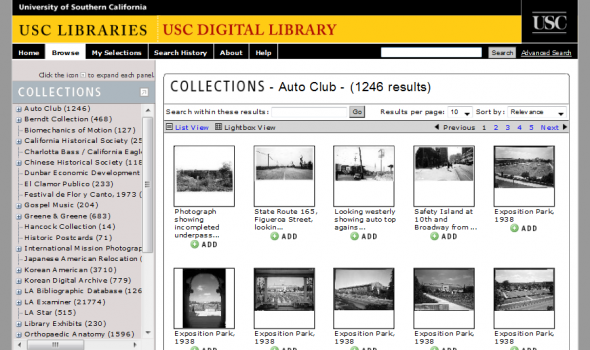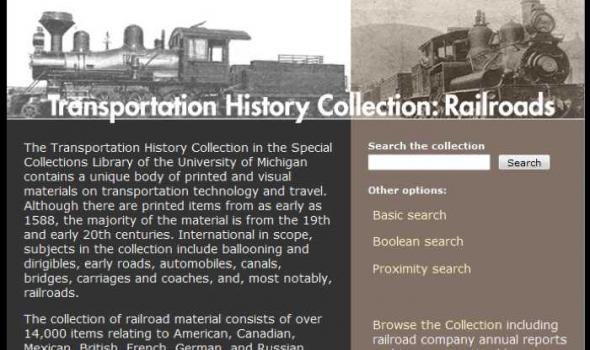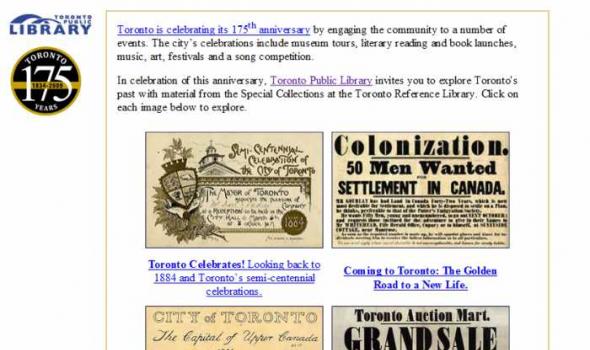Railroads
- Auto Club Collection Description The Automobile Club of Southern California Digital Archive provides documentation on the region's transportation history, expecially Los Angeles from 1892 to 1963, from the Auto Club's Corporate Archives. The Digital Archive includes: a selection of 98 historic strip maps, illustrating the development of major Southern California routes; 498 photographs from the general photograph collection, depicting buildings, businesses, streets, and points of interest; and 650 photographs from engineering notebooks along with searchable transcriptions of the engineers' notes documenting the conditions of streets, highways, bridges, railroads, etc.
The Transportation History Collection in the Special Collections Library of the University of Michigan contains a unique body of printed and visual materials on transportation technology and travel. Although there are printed items from as early as 1588, the majority of the material is from the 19th and early 20th centuries. International in scope, subjects in the collection include ballooning and dirigibles, early roads, automobiles, canals, bridges, carriages and coaches, and, most notably, railroads. The collection of railroad material consists of over 14,000 items relating to American, Canadian, Mexican, British, French, German, and Russian railroad companies and their rolling stock.
About the Stevens Family Papers This is a collection of correspondence and other papers relating to Robert S. Stevens' work as manager of the Missouri, Kansas, and Texas Railway and the Hannibal and St. Joseph Railroad, and to his investments in Kansas lands. This collection is dated from 1805 - 1899. For more information, go to the Guide to the Stevens Family Papers . For additional information about Cornell University Library's Archival Guides, go to the Guides for Archival and Manuscript Collections . For reference questions, please complete our reference form . For feedback about this website, contact rmcweb@cornell.edu .
DIGITAL COLLECTIONS About Stereographs A stereograph, also known as a stereogram or stereo view, is a double photograph that appears three-dimensional when viewed through a stereoscope. Scientist Charles Wheatstone invented a reflecting stereoscope in 1838 as a laboratory instrument. Some photographers did use this instrument to exhibit photographs, but it was not until the development of the lenticular stereoscope in 1850 by Sir William Brewster that stereographs became popular. They reached their height of popularity between 1870 and 1890 but continued to be created until as late as 1940. The term "stereograph" is said to have originated with Oliver Wendell Holmes who, in addition to being an author, poet, physician, and lecturer, invented a hand stereoscope in 1859.
Toronto is celebrating its 175 th anniversary by engaging the community to a number of events. The city’s celebrations include museum tours, literary reading and book launches, music, art, festivals and a song competition. In celebration of this anniversary, Toronto Public Library invites you to explore Toronto's past with material from the Special Collections at the Toronto Reference Library. Click on each image below to explore. To learn more about the history of Toronto, explore these past exhibits: Also, check out the following two books from our Curator's Showcase : To search for more historical images of Toronto from our collections:
The Toronto Public Library (TPL) has long been committed to an active exhibition program for its Local History and Special Collections in the Canada Trust Gallery at the Toronto Reference Library and other Library venues. The virtual version of All Aboard Toronto ? Railways and the Growth of a City , fully re-creates the exhibition on display in our Gallery from August 4 ? October 7, 2001. The exhibition explores Toronto railway history and its impact on the development of the city from the 1850s to the end of the steam era in the mid 20th century. It is illustrated with over a hundred collection items including paintings, drawings, maps, postcards, broadsides and other ephemera.
The Erie Railroad Glass Plate Negative Collection Using the Collection The collection of 709 images can be accessed via the Library's CONTENTdm server and is fully searchable by keyword, subject, and image number. The item level inventory of the collection in Excel can help with formulating searches and sorting. NOTE: both links will open new windows. About the Collection The Erie Railroad Company glass plate negatives are arranged by Erie subsidiary railroads in the states of New York, New Jersey, Pennsylvania, and Ohio. Mainline scenes come from all of the preceding states, as well as from Indiana and Illinois.


























